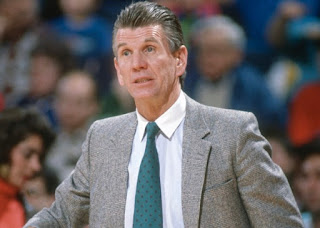95% of players who I coached all SAY they want to play fastbreak basketball. When a players says they want to be on a fastbreak team, they visualize catching the ball ahead of everyone and either scoring at the basket or stopping for a wide open three.
When players SAY they want to run, they think about the last 15 feet of the fastbreak. They don’t realize the fastbreak is made in the first 20 feet of transition. The last 15 feet is the easy part- getting to the last 15 feet is HARD work. I guess the message is that many players like the idea of running a fastbreak but are not crazy about the idea of running each possession, and hate the idea of sprinting over and over. 95% of the players who I coached were not excited about doing the running in practice needed to become a fastbreak team.
I once heard Paul Westhead say something to the effect that-
1- Players love the idea of being a running team.
2- Players hate the running involved in practice as a running team.
3- Players love the result of running in games.
I saw a clip from John Calipari on Twitter where he said that they go through practice and game tape to “grade” each player from A to F on each transition from defense to offense. His scale was something like this-
A= Must sprint this possession starting with first three strides and then continue.
B= Run first three strides then sprint.
C= Run, don’t sprint
D= Start running, analyze the defense and decide to jog
E= Don’t beat the ball to half-court
Calipari claimed he uses this info to counsel players. He claimed his message was something to the effect,”You were on the floor for 25 transition but only got an A on 10. I didn’t realize I was playing you too many minutes so you are needing to pace yourself. I can give you more rest in the future.”
As a coach, I absolutely hated the “analyzing runner.” They are the runner who starts out running but looks over the floor and decides that they don’t think we will get a fastbreak so it is time to slow down and wait to set up. If you are going to be a fastbreak team, you MUST have players- especially two wings and one post- who are sprinting every possession. Even if you don’t get a layup, sprinting makes the defense have to scramble with their matchups.
This winter Hannah Stuelke for Iowa was unbelievable. There were times she might even get the defensive board, throw a quick outlet, and go. When she was just at the top of the key of her defensive end, she might have been 10 feet behind the defender running down, but by the time they got to the far top of the key, she was often 10 feet ahead of her defender and got a layup. For the Fever as Boston is becoming more and more of a dominate rebounder- they need a post who is going to out run the defense.
But what people don’t realize, even if the post doesnn’t get a layup- it puts a real strain on the defense. Maybe a guard defender saw Stuelke coming so they rotate to prevent the layup, that rotation takes away the layup but it leaves a wing open for a three.
I am very interested to see what happens with Lexie Hull’s development with the Fever. During the second half of the season, if you get a chance to watch, don’t watch the ball when Indiana gets a rebound- watch Hull take off. Every game just by ALL OUT sprinting, she gets a couple passes from Clark for layups. Right now she doesn’t shoot well but eventually she could be deadly in transition as a three point shooter if she continues to sprint the floor.
I guess my thought would be that if a team really wants to be a fastbreak team, the players must realize it cannot be just running some possessions, it has to be sprinting all the time.
To succeed, fastbreak teams need a great point guard who can see the floor, but they MUST have posts and wings like Stuelke and Hull who are willing to sprint 15 times in a row even if they only get the ball thrown once to them!







No comments:
Post a Comment